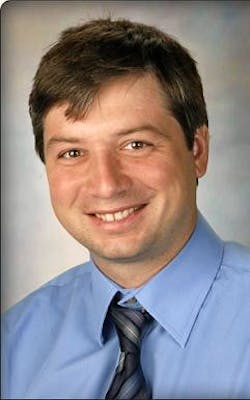New Wasatch Photonics principal scientist to develop OCT imaging systems

Logan, UT and Durham, NC--Wasatch Photonics--part of the Purdue Research Park-- has hired imaging technology expert Roman Kuranov as principal scientist to oversee development of the company's Optical Coherence Tomography (OCT) imaging systems, providing information for diagnostics and modeling of disease. He previously had been a research faculty member in the Department of Ophthalmology in the University of Texas Health Science Center at San Antonio, and research and development engineer at Volcano Corporation and CardioSpectra.
Mike Sullivan, general manager of Wasatch Photonics, said Kuranov brings experience and leadership to the company. "Roman brings comprehensive academic and industrial experience that will greatly benefit Wasatch Photonics by improving our OCT imaging capabilities," Sullivan said. "He has a track record of success and will lead our efforts on the Intra-Venous (IV)-OCT grant and other OCT imaging equipment."
Kuranov said joining Wasatch Photonics is an excellent career opportunity. "It is a very professional, ethical company with creative management. My vision for developing the OCT imaging systems matches the company's vision," he said.
Wasatch Photonics, founded in 2002, designs, manufactures and markets high-performance Raman spectrometers, OCT systems, enhanced holographic optics for optical networking, spectroscopy, test and measurement, and medical imaging applications. Their high-performance volume holographic optical elements (HOEs) and gratings are used in a diverse set of industries, including those in the defense and security, chemical manufacturing, pharmaceutical, medical, energy, education, computer, and electronics markets. Their products are based on proprietary holographic recording media and Dickson grating technologies.
The Purdue Research Park, with four locations across Indiana, has the largest university-affiliated business incubation complex in the country. The park network is home to about 200 companies that employ 4000 people and is located in West Lafayette, Indianapolis, Merrillville, and New Albany, IN.
SOURCE: Purdue Research Park News; http://purdueresearchpark.com/news/wasatch-photonics-hires-principal-scientist-develop-imaging-technology
About the Author

Gail Overton
Senior Editor (2004-2020)
Gail has more than 30 years of engineering, marketing, product management, and editorial experience in the photonics and optical communications industry. Before joining the staff at Laser Focus World in 2004, she held many product management and product marketing roles in the fiber-optics industry, most notably at Hughes (El Segundo, CA), GTE Labs (Waltham, MA), Corning (Corning, NY), Photon Kinetics (Beaverton, OR), and Newport Corporation (Irvine, CA). During her marketing career, Gail published articles in WDM Solutions and Sensors magazine and traveled internationally to conduct product and sales training. Gail received her BS degree in physics, with an emphasis in optics, from San Diego State University in San Diego, CA in May 1986.